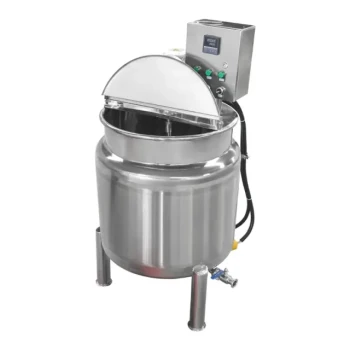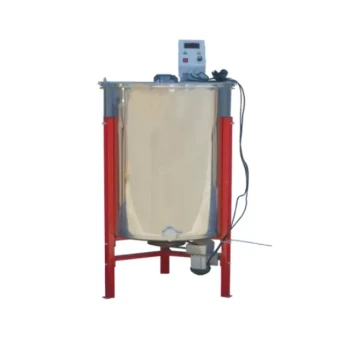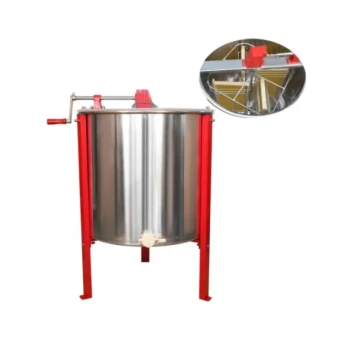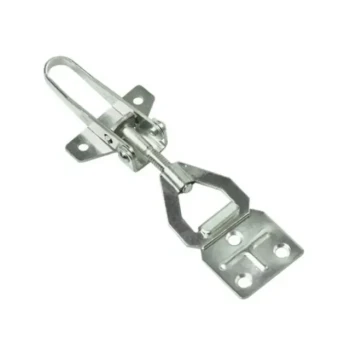For the best results, the ideal temperature for honey in a press is between 80°F and 95°F (27°C to 35°C). This gentle warmth significantly improves the honey's flow without damaging its delicate enzymes, nutrients, and flavor. Exceeding 104°F (40°C) will begin to degrade the quality of the honey, a process that accelerates rapidly with higher heat.
The goal is not to "heat" the honey, but to gently warm the comb to mimic the natural temperature of a beehive. This reduces the honey's viscosity (thickness), allowing it to flow freely from the press while preserving its raw, natural qualities.
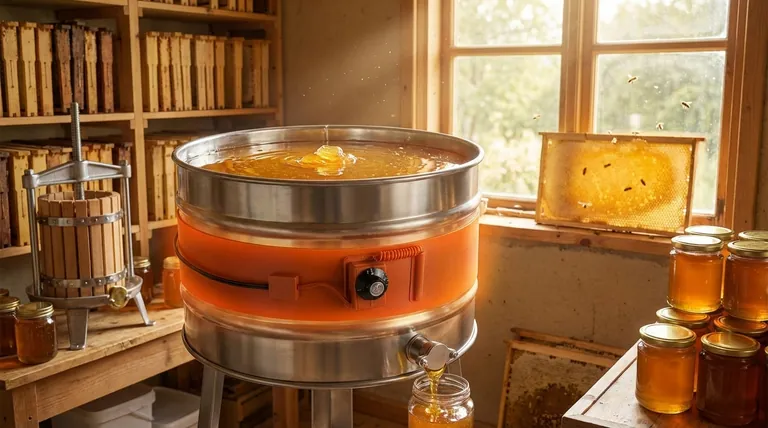
Why Temperature is Critical for Honey Pressing
To effectively press honey, you must first understand the fundamental relationship between temperature, viscosity, and quality. The right temperature makes the process efficient; the wrong temperature can ruin your entire harvest.
The Science of Honey Viscosity
Honey is naturally thick, or viscous. Its viscosity is highly dependent on temperature.
When honey is cool—especially below 70°F (21°C)—it becomes extremely thick and resists flowing. Applying pressure to cold comb results in a very low yield and can even damage your equipment.
As you gently warm the honey, its viscosity decreases dramatically, allowing it to flow easily under pressure. This is the key to efficient extraction.
Mimicking the Natural Hive Environment
A healthy, active beehive maintains an internal temperature of approximately 95°F (35°C). At this temperature, honey is at its ideal fluidity for the bees to manage.
By warming your comb to this range, you are simply restoring the honey to its natural state, making extraction as easy as possible.
The Unseen Damage of Overheating
The most common mistake is applying too much heat in an attempt to speed up the process. This has severe consequences.
Temperatures above 104°F (40°C) begin to destroy the beneficial enzymes, such as diastase and invertase, that are key indicators of high-quality, raw honey. Excessive heat also fundamentally alters the honey's flavor and aroma and can increase levels of HMF (Hydroxymethylfurfural), a compound used to measure heat exposure and age.
Recommended Temperature and Best Practices
Achieving the perfect balance of yield and quality requires careful temperature management.
The Ideal Working Range
Aim for a comb temperature of at least 80°F (27°C). This is the minimum for an effective and timely press.
If the temperature drops below 70°F (21°C), the process will slow considerably, potentially taking several days to complete instead of several hours.
The optimal range is between 80°F and 95°F (27°C to 35°C).
How to Gently Warm Your Comb
Uniform, gentle heat is crucial. Never apply direct, high heat.
Good methods include placing your supers or buckets of comb in a small, insulated room with a space heater or using a dedicated warming cabinet. This allows the comb to warm slowly and evenly over several hours.
Plan for the Time Factor
Properly warmed comb will press and strain much more quickly. At 80°F or warmer, you can expect the bulk of your honey to strain within a day. In cooler conditions, you must be prepared for a much slower, multi-day process.
Understanding the Pitfalls
Avoiding common mistakes is as important as following best practices. A little patience goes a long way in preserving the value of your honey.
The False Economy of Speed
The primary pitfall is impatience. Using a heat gun, placing comb in a hot oven, or using other direct heat sources may seem faster, but it will create hot spots that scorch and degrade the honey, rendering it far less valuable.
Ignoring Your Environment
Remember that a cold press and collection bucket will rapidly cool your warm honey. If you are working in a cool garage or shed, consider pre-warming your equipment to help maintain the honey's temperature throughout the process.
Making the Right Choice for Your Goal
Your approach to temperature can be fine-tuned based on your primary objective.
- If your primary focus is preserving maximum raw quality: Keep the comb at the lower end of the effective range, around 80-85°F (27-29°C), and allow for a slightly longer pressing and straining time.
- If your primary focus is maximizing efficiency and yield: Aim for the higher end of the safe range, around 90-95°F (32-35°C), to ensure the honey flows as quickly and completely as possible.
- If you are working in a cool climate: Your main challenge is heat loss. Use an insulated warming box for your comb and consider ways to keep the press and collection vessel from becoming a heat sink.
Ultimately, mastering temperature control is the key to transforming your hard work into a high-quality, beautifully extracted final product.
Summary Table:
| Key Temperature Range | Purpose & Effect | Pitfall to Avoid |
|---|---|---|
| 80°F - 95°F (27°C - 35°C) | Mimics the hive environment; reduces viscosity for efficient flow while preserving raw quality. | Temperatures exceeding 104°F (40°C) degrade enzymes, flavor, and increase HMF levels. |
Achieve a perfect harvest with the right equipment. Mastering temperature is just one part of a successful honey pressing operation. HONESTBEE supplies commercial apiaries and beekeeping equipment distributors with the durable, high-performance supplies needed for every step of the process. From warming cabinets to heavy-duty presses, our wholesale-focused operations ensure you get the reliable gear that protects your honey's quality and boosts your efficiency.
Contact our experts today to discuss your apiary's specific needs and discover how our equipment can help you maximize yield without compromising quality.
Visual Guide
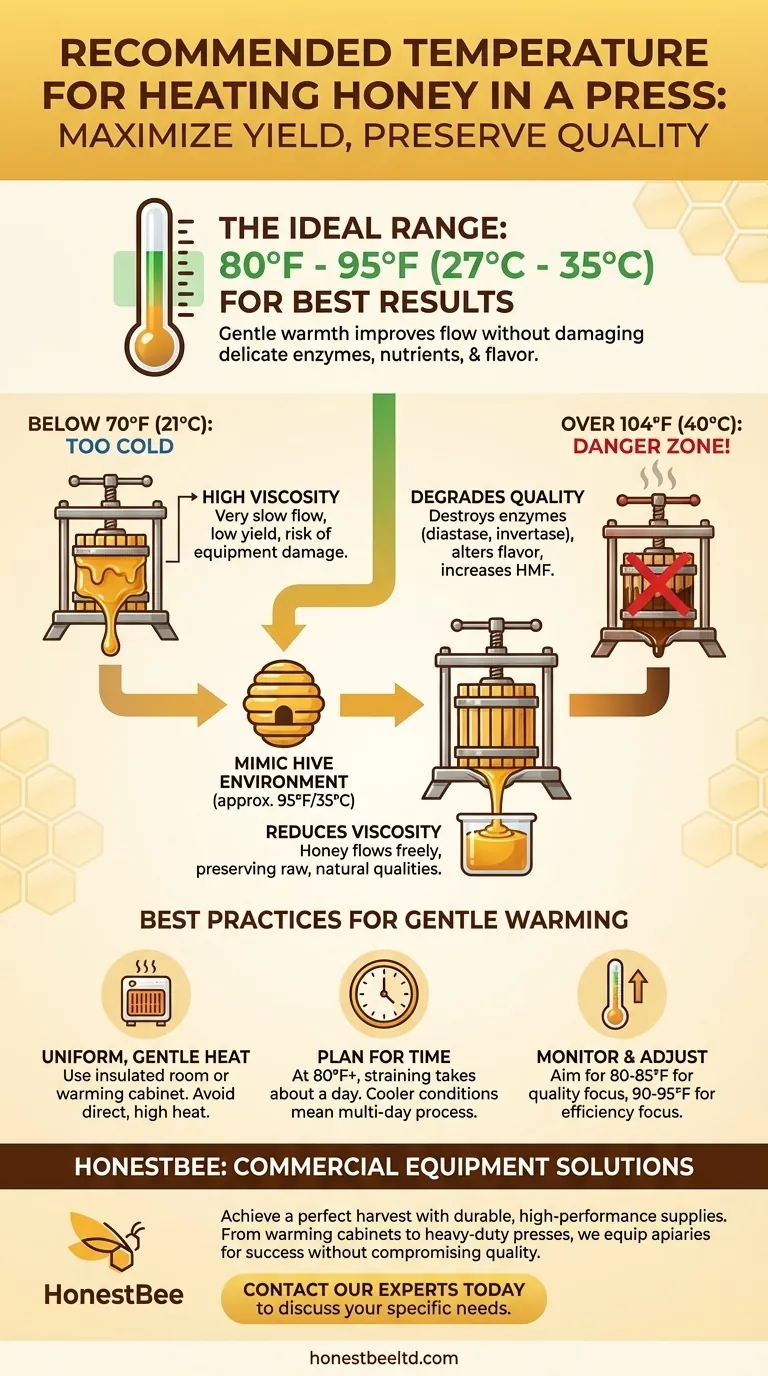
Related Products
- Silicone Rubber Honey Drum Heating Belt
- Easy Use Manual Stainless Steel Honey Press for Honey Comb
- Electric 8 Frame Honey Spinner Extractor Equipment for Beekeeping
- Double Wall Honey Heating Stirring Homogenizer Mixing Machine with Various Capacity
- Stainless Steel Manual 8 Frame Radial Honey Extractor Machine for Beehives
People Also Ask
- Why is quality processing equipment important in honey production? Ensure Purity, Efficiency, and Brand Reputation
- How do you heat honey for bottling? Preserve Quality with Gentle Warming Techniques
- How do bees extract nectar from flowers? A Masterclass in Natural Engineering
- Can you heat honey to remove moisture? Safely Preserve Honey Quality with Controlled Drying
- How does the Bee Blanket compare to traditional heating methods? Preserve Honey Quality with Gentle Heat



